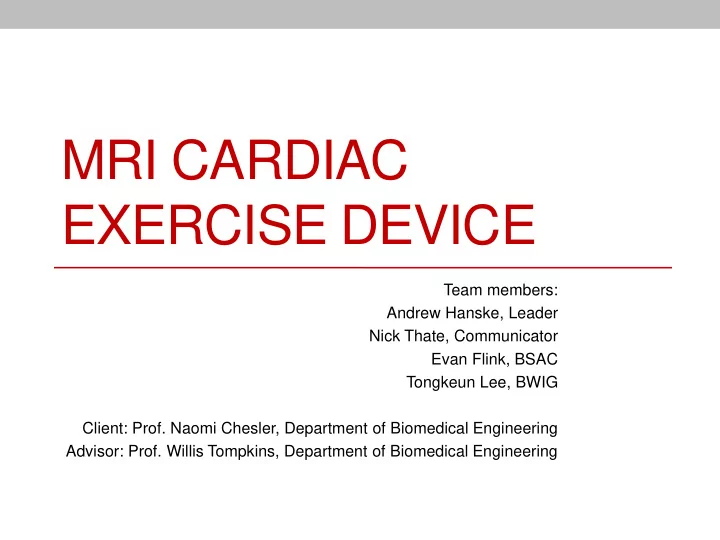

MRI CARDIAC EXERCISE DEVICE Team members: Andrew Hanske, Leader Nick Thate, Communicator Evan Flink, BSAC Tongkeun Lee, BWIG Client: Prof. Naomi Chesler, Department of Biomedical Engineering Advisor: Prof. Willis Tompkins, Department of Biomedical Engineering
Outline • Problem Statement • Background Information • Competition / Past BME Designs • Previous Prototype • Design, Testing, and Problems • Lateral Arm Stability Designs • Securing Patient to Device Designs • Additional Design Improvements • Future Work • Acknowledgements / References
Problem Statement • Design an exercise device to be used in cardiac MRI scans in order to diagnose and assess pulmonary hypertension • Client requirements • MRI compatible materials • Exercise within the bore • Comfortable supine exercise motion • Minimal upper-body movement • Sufficient resistance to increase cardiac output • Adjustable workloads • Reasonable size and weight
Background Information • Pulmonary Hypertension • Abnormally high blood pressure in pulmonary arteries • Decreased artery diameter • Enlarged right ventricle • Decreased systemic blood [O 2 ] • Traditionally assessed with invasive procedure http://health.allrefer.com/health/primary- pulmonary-hypertension-primary-pulmonary- hypertension.html
Competition • Lode B.V. MRI Ergometer • Expensive ( > $28,000) • Cycling motion http://www.lode.nl/en/pr oducts/mri_ergometer • Cannot exercise in bore during chest scans • MRI-compatible treadmill • Developed at Ohio State University • Exercise occurs outside of the MRI tube • Less accurate results http://www.medcitynews.com/2009/0 5/commercialization-ramps-up-on- ohio-state-university-treadmill-used- for-mri-heart-tests/
Past BME Designs • MRI Lower Leg Exerciser • MRI Leg Exercise Device • Spring 2010 • Fall 2010 • Excess friction • Unnatural loading • Insufficient workload • Bulky
Previous Prototype: Design
Previous Prototype: Testing • Used 6.77 kg additional mass per leg • Worked at a cadence of ~130 steps/min • Equivalent to ~62 Watts • Tests lasted 10 minutes • Maximum heart rate measured via pulse oximeter Subject Resting HR (bpm) Exercising HR (bpm) % Max. HR 1 65 130 65.33 2 62 128 64.32 3 62 118 59.30 4 58 146 73.37 Average 61.75 130.50 65.58
Previous Prototype: Problems • Durability of the prototype • Lateral lever arm stability • Lateral foot movement • Bearings • Compatibility with the sliding MRI couch • Device and subject movement • Size • Sliding weights
Lateral Lever Arm Stability Design: Track-Guided • Extension on arm moves through external track Pros: • Cost-effective Cons: • Friction • Indirect solution
Lateral Lever Arm Stability Design: Block • Two bearings housed in block • Provides even support • Secures bearings Pros: • Reduces friction/wear • Limits lateral motion Cons: • Additional bearings
Lateral Lever Arm Stability Design: Arc-Support • Support arms provide increased interface with bar Pros: • Limits lateral motion • Cost-effective Cons: • Durability concerns • Friction
Lateral Lever Arm Stability Design: Design Matrix Weight Criteria Track-Guided Block Arc-Support 0.4 Effectiveness 4 8 9 0.4 Durability 5 9 6 0.1 Ease of Assembly 7 8 6 0.1 Cost 8 6 8 Weighted Total: 5.1 8.2 7.4
Securing Patient to Device Design: Extended Base • Elongated base with padded shoulder supports Pros: • Effective Cons: • Bulky • Expensive
Securing Patient to Device Design: Backpack Straps • Shoulder straps secure patient to device Pros: • Comfortable and effective • Light-weight Cons: • Restrictive
Securing Patient to Device Design: Velcro Yoga Mat • Velcro belt attaches to Pros: underlying yoga mat • Light-weight Cons: • Less comfortable • Durability concerns Yoga mat Velcro interface
Securing Patient to Device Design: Design Matrix Backpack Weight Criteria Extended Base Velcro Yoga Mat Straps 0.25 Effectiveness 9 9 6 0.2 Patient Comfort 7 8 6 0.15 Size/Weight 3 9 8 0.15 Durability 7 7 5 0.15 Safety 10 8 7 0.1 Cost 5 7 6 Weighted Total: 7.15 8.15 6.3
Additional Design Improvements • More comfortable hand straps • Foot straps • Decreased lever arm length • Tracking under base • Compatible w/ couch movement • Stopping mechanism • Threaded aluminum rod • Improved weight interface
Future Work • Order new materials • Salvage/recycle older components • Construct and assemble new prototype • Test effectiveness of prototype • Test compatibility of prototype with MRI • IRB approval • Acquire pulmonary arterial blood pressure data through MRI scans before, during, and after exercise • Varied subject demographics
Acknowledgements • Prof. Naomi Chesler • Prof. Willis Tompkins • Dr. Alejandro Roldan • Dr. Oliver Wieben • Prof. Darryl Thelen • Jarred Kaiser • Previous BME Design Teams References • Blaivas, A.J. (2010, April 27). Pulmonary hypertension . Retrieved from http://www.ncbi.nlm.nih.gov/pubmedhealth/PMH0001171/ • Lode B.V. (2008). MRI Ergometer . Retrieved from http://www.lode.nl/en/products/mri_ergometer • McGuire, J., et. al. (2010, December 10). MRI exercise device. Retrieved from http://bmedesign.engr.wisc.edu/websites/project.php?id=332 • Murray, A. (2009, May 14). Ohio state team creates new company based on university invention . Retrieved from http://www.osu.edu/news/newsitem2425 • Yagow, D., et. al. (2010, May 6). An MRI-compatible lower-leg exercising device for assessing pulmonary arterial pressure. Retrieved from http://bmedesign.engr.wisc.edu/websites/project.php?id=29
Recommend
More recommend